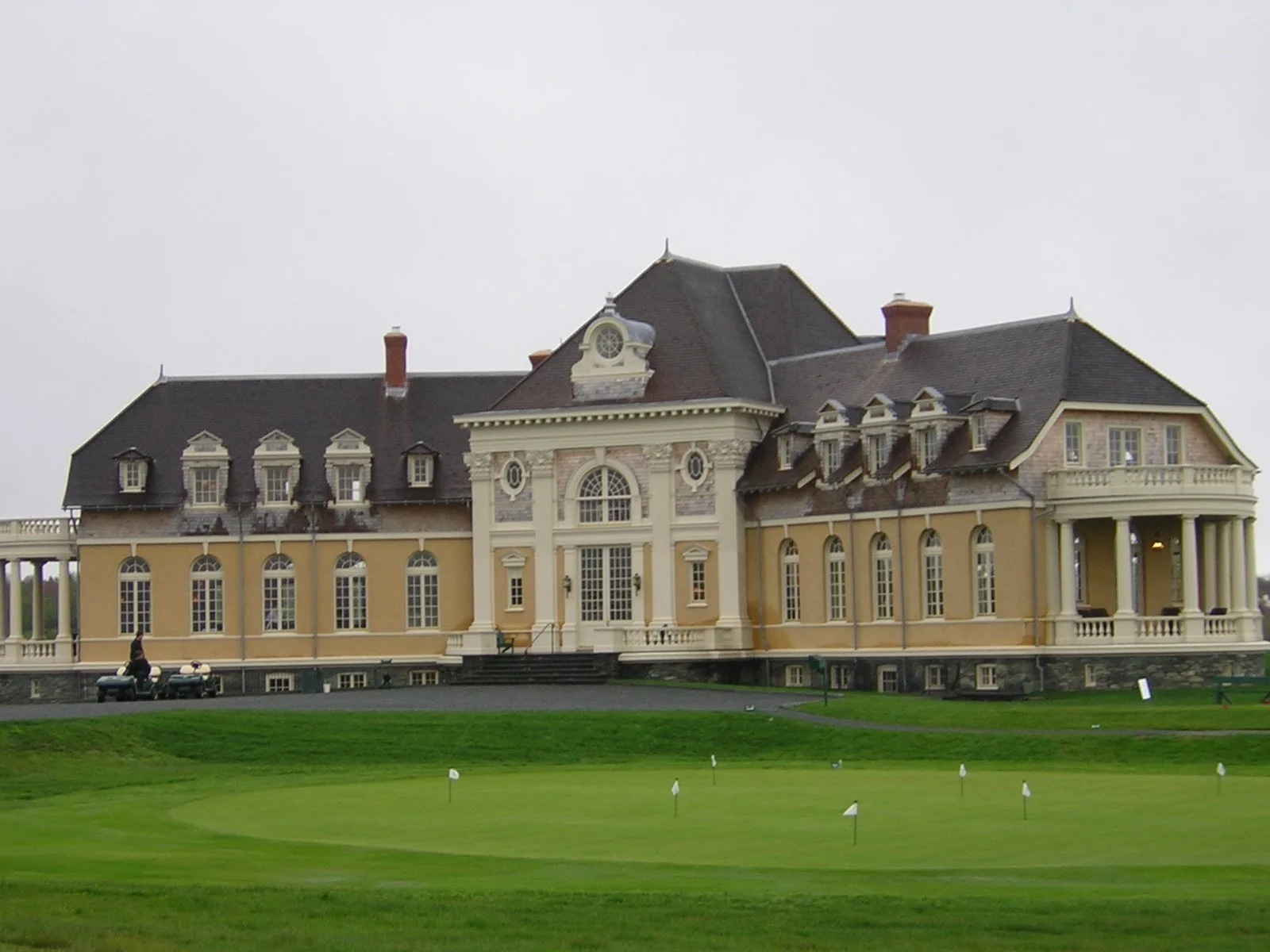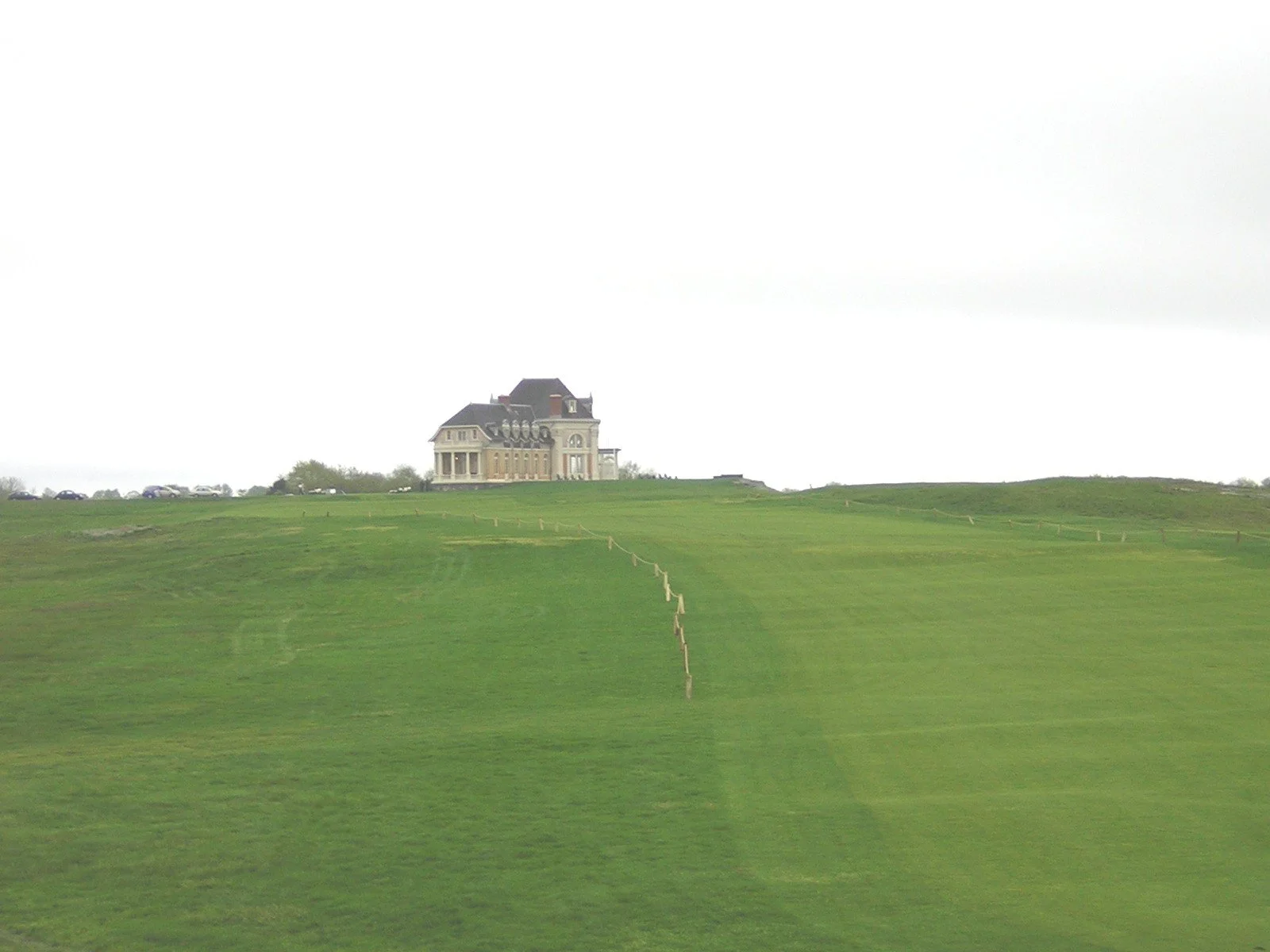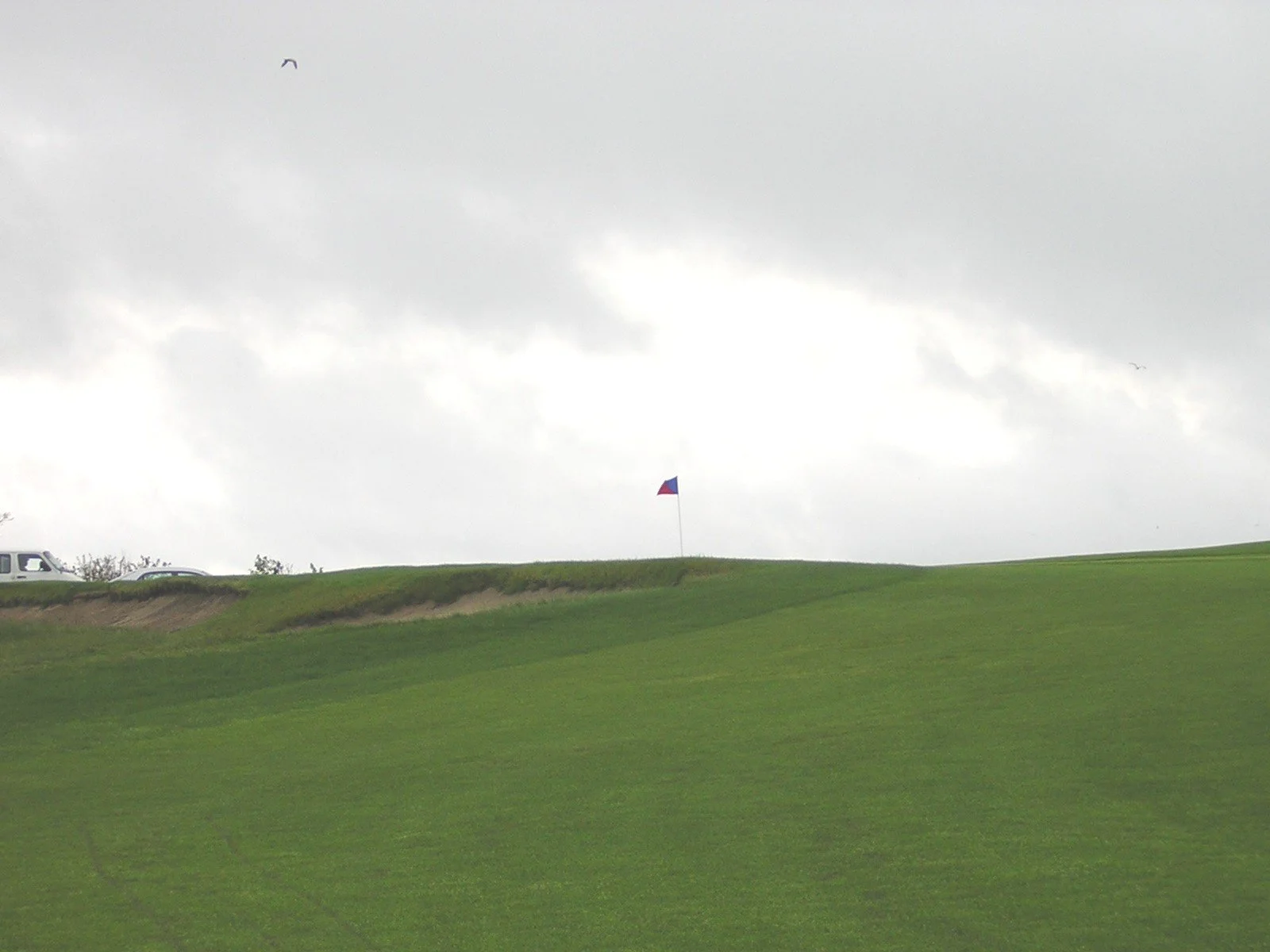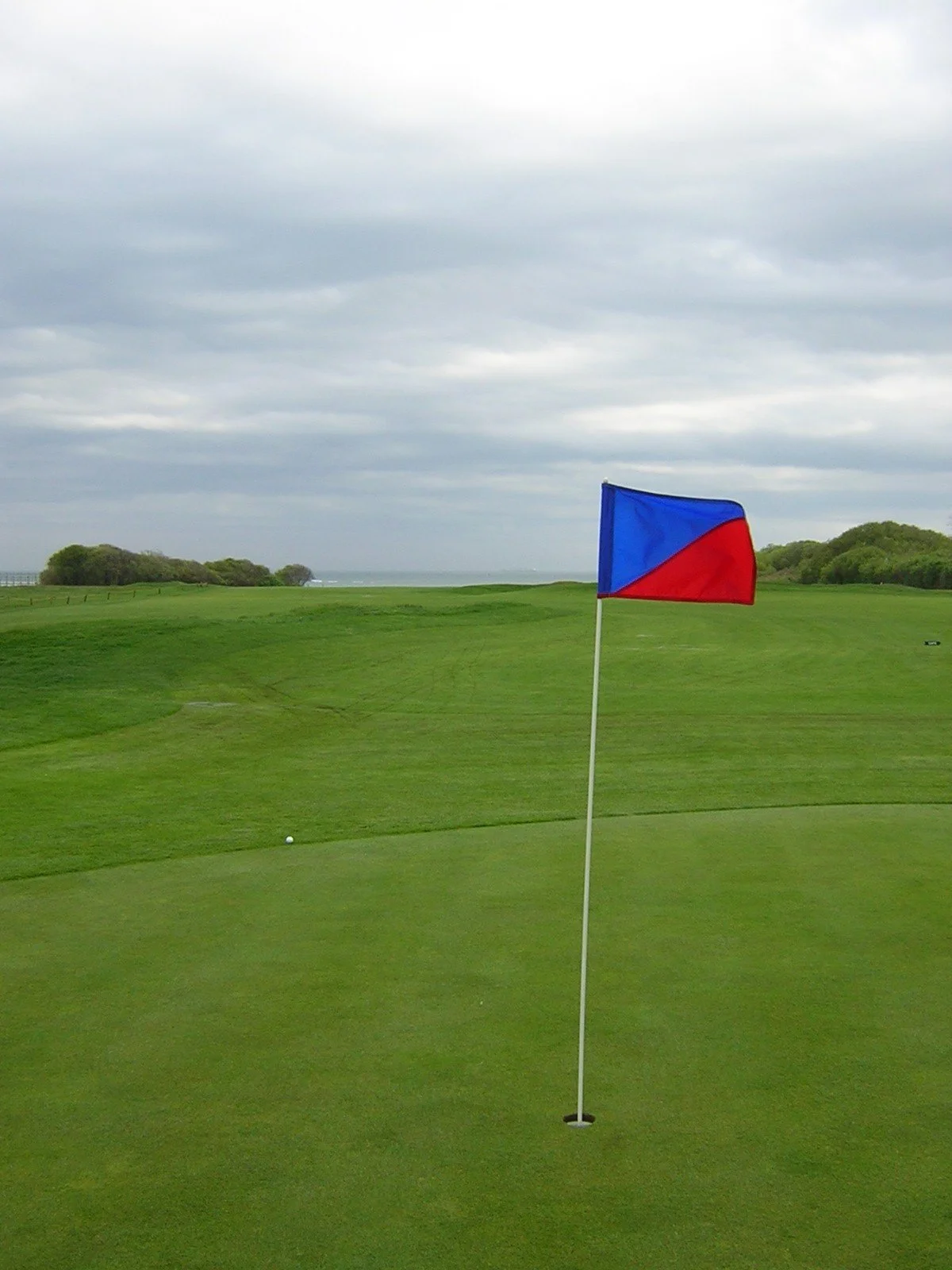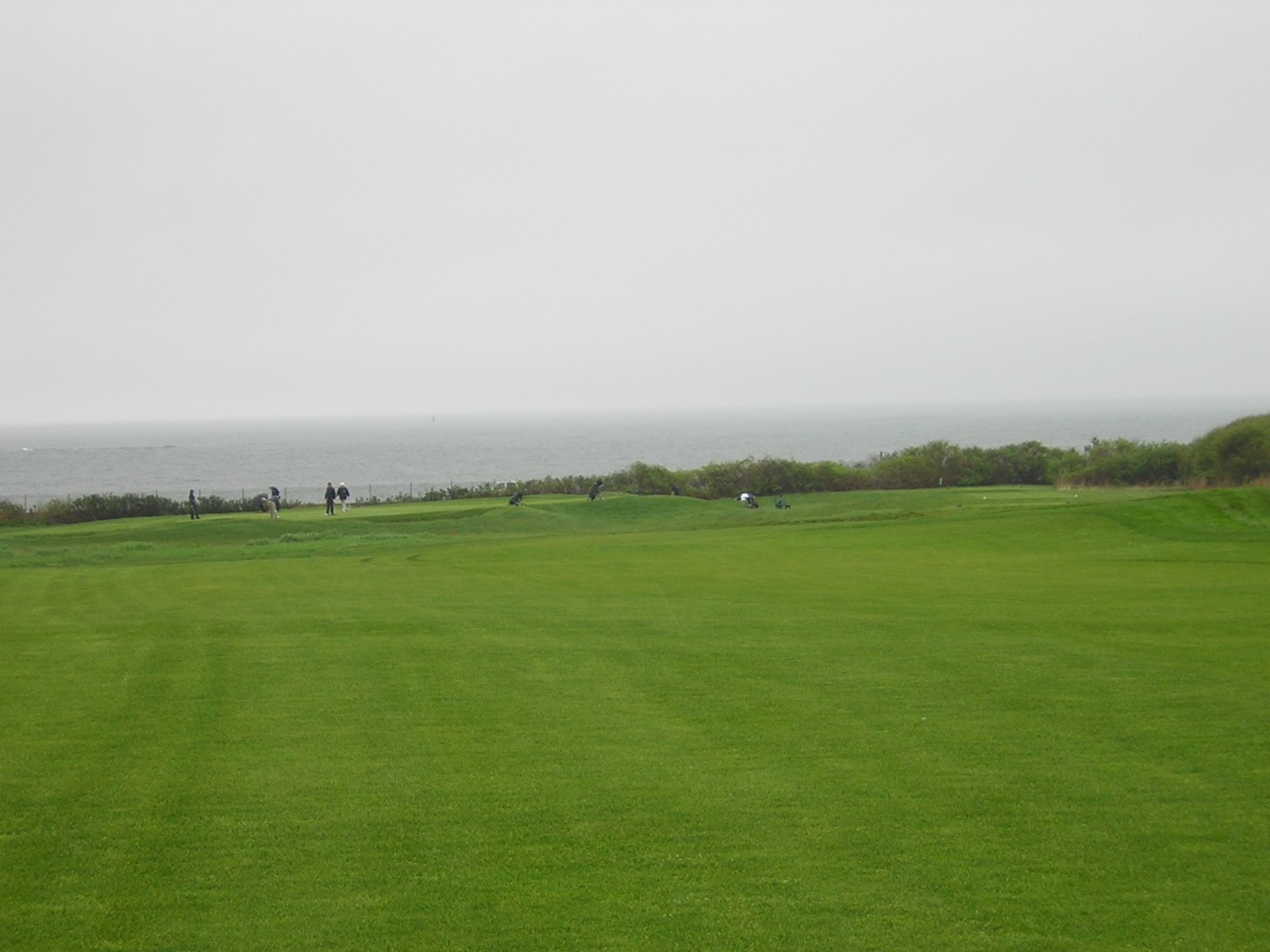NEWPORT COUNTRY CLUB
Course Architect(s): William Davis (1893), Donald Ross (1915),
A.W. Tillinghast (1923-24), Orrin S. Smith,
Ron Forse (1998-2004), Gil Hanse (2018-2020)
Year Opened: 1893
Location: Newport, Rhode Island
Slope: 135. Rating: 75.4
Par: 70
Yardage: 6,831
Hole-by-Hole: 1 - Par 4 459 Yds 10 - Par 5 535 Yds
2 - Par 4 390 Yds 11 - Par 4 298 Yds
3 - Par 4 345 Yds 12 - Par 4 463 Yds
4 - Par 3 225 Yds 13 - Par 3 166 Yds
5 - Par 4 451 Yds 14 - Par 3 209 Yds
6 - Par 4 418 Yds 15 - Par 4 436 Yds
7 - Par 5 552 Yds 16 - Par 4 359 Yds
8 - Par 3 194 Yds 17 - Par 4 449 Yds
9 - Par 4 448 Yds 18 - Par 4 434 Yds
Par 35 3,482 Yds Par 35 3,349 Yds
Key Events Held: U.S. Amateur (1895, 1995),
U.S. Open (1895),
Golf Digest Commemorative Pro-Am (1980-81),
Merrill Lynch/Golf Digest Commemorative Pro-Am (1982-85),
Newport Cup (1987-92),
U.S. Women's Open (2006), U.S. Senior Open (2024).
Awards Won: Ranked #2 by Golf Digest - Best in State (Rhode Island) (2006),
Ranked #10 by Golf Connoisseur - Most prestigious private clubs in America (2006),
Ranked #47 by Golfweek - America's top-100 Classic Courses (2006),
Ranked #81 by Golf Magazine - Top-100 Courses in U.S. (2005).
Website: newportcountryclub.us
HISTORY: All you need to know is that Newport Country Club is one of the five founding clubs of the USGA, along with Chicago Golf Club, St. Andrews, The Country Club and Shinnecock Hills Golf Club. That should tell you something about the history of this great golf course.
Located on the Rhode Island coast, the original golf course was designed by William Davis, the club's first golf professional. Davis laid out the first nine holes, which would host the first two United States Golf Association championships, the U.S. Amateur and the U.S. Open in 1895. The site featured very little in regards to housing and vegetation, such as trees. During the years of 1776-78, when the British Military occupied the land, firewood cutting and land clearing wiped out most of the natural beauty of the property. Rumor has it that the ridges on the 10th fairway might be where a former encampment site of the French occupying forces lay waiting for a possible British attack by sea.
The first event held at Newport was a match between Davis and Willie Dunn, who was the head professional at Shinnecock Hills. The club donated the purse for the nine-hole match, which was won by Dunn, 45-46. Considering the initiation fees around the country in this day and age, a modest $100 would have made you a member at Newport with annual dues of $30. In just the first year, the club had swelled to 70 members.
The Rocky Farm Course at Newport Country Club was founded by none other than the first USGA President, Theodore Havermeyer, who reportedly paid the expenses of the contestants in order to ensure that the best players would play in the Amateur and Open events. Famed golf course architect Charles Blair Macdonald captured the inaugural United States Amateur, as he bested Charles E. Sands, 12 & 11, in the final. Other founding members of Newport CC were
John Jacob Astor and three of the Vanderbilt family -- Cornelius, Frederick and William. Havermeyer and company purchased 140 acres from the King family for $80,000. During 1894-95 a new clubhouse was built by Whitney Warren, an architect who studied in France. The style of the clubhouse has hints of the architecture of Louis XIII.
The 1895 U.S. Open Championship fielded just 11 players, including one amateur the day after the Amateur. The course of action was to play the nine-hole layout four times. The favorite at the time was Willie Dunn, considered to be one of the finest players of his time. Willie Campbell led after the opening nine with a score of 41, two ahead of Dunn and four ahead of Horace Rawlins
and two other players. Campbell struggled during the second nine, but was tied for the lead at the halfway point with Dunn and James Foulis. Rawlins, a local professional, was two strokes behind. All played on the same day, the final round saw Campbell take a one-shot advantage over Rawlins with just nine holes remaining, while Dunn trailed by two. During the final nine, Campbell fell
apart, making a 9 on the third hole and a 7 on the next en route to a 48 and a sixth-place finish. Rawlins and Dunn battled over the final holes, with Rawlins prevailing by one, as he claimed the $150 first-place prize and a gold medal. A.W. Smith, the lone amateur, finished three shots back in a tie for third with Foulis. To this day, Rawlins remains the lone player to win a U.S. Open on a course in which he was employed as a professional.
In 1915, Donald Ross was brought in to design a new 18-hole course, next door to the original layout. Changes were made to the existing layout when A.W. Tillinghast, designer of Winged Foot, Baltusrol, Quaker Ridge and San Francisco Golf Club, was brought in during the 1920s. Tillinghast rerouted some of the old course and designed nine new holes. With the purchase of
additional land, Tillinghast needed to design part of the course so that none of the shots near the adjacent Ocean Drive would be affected by wayward shots. The course played today is virtually the same venue played back then, with some modern modifications.
As with most courses during World War II, membership dropped to just 56, as gasoline restrictions forced the clubhouse to shut down. After the war, the club began to flourish once again, thanks in part to a $25,000, 70-year mortgage.
The Champions Tour, previously called the Senior Tour, made its mark at Newport with the Golf Digest Commemorative Pro-Am, an unofficial event the first two years, followed by the Merrill Lynch/Golf Digest Commemorative Pro-Am from 1983-85 and then the Newport Cup (1987-92). Winners of this event read like a who's who, from Sam Snead, Billy Casper, Miller Barber and Roberto De Vicenzo to Lee Elder and Jim Dent. Barber and Dent were two-time winners of this event, with Dent also finishing second twice. When Elder won the tournament in 1985, he carded an 11-under par 61 during the opening round. Elder needed an eagle three on the first extra hole to defeat Peter Thomson in a playoff.
The USGA returned to Newport Country Club 100 years after it's opening U.S. Amateur to host the 95th staging of this storied event. It was a remarkable event, as Tiger Woods defeated George "Buddy" Marucci, 2-up in a classic final. In his first attempt at the U.S. Amateur in 1991, Woods failed to qualify for match play. In his second and third attempts, he lost in the
second round on both occasions. Woods then began his streak of three consecutive U.S. Amateur titles in 1994 at the TPC at Sawgrass and closed it off with his win at Pumpkin Ridge in 1996.
After three weeks of no rain, the course for the 1995 Amateur was as firm as an unripe Georgia Peach. Drives bounced 50 yards extra down the fairway, making par fives reachable in two with irons and par fours accessible with wedges. The road to match play was not an easy one for Woods, who, despite an opening 68, shot 75 on the second day to qualify just two shots inside the
number. Notable PGA players to make match play included Chad Campbell, Matthew Goggin, Notah Begay III, Charles Howell III and Chris Riley. Woods opened with a 3 & 2 win over Patrick Lee and then followed it up with a 4 & 2 victory over Campbell. Sean Knapp, who dispatched of Begay in the second round, was Woods' next victim at 2 & 1. With wins over Scott Kammann and Mark Plummer, Woods reached the championship match. Marucci had a more difficult time advancing to the final, as he was forced to extra holes three times.
The 36-hole final saw Marucci take a 3-up lead over Woods through 12 holes. Woods closed the gap to one after the opening 18 holes. After birdies on the 21st and 24th holes, Woods had claimed his first lead of the match since the third tee. Marucci pitched in on the 26th hole to square the match, however, Woods reclaimed the lead for good on the 30th. Woods began his fist-pumping charge with an 18-footer for birdie on the 33rd hole to go two-up, as Marucci missed from 20-feet. Marucci closed to within 1-down after winning the 35th hole, however Woods closed out the match by sticking his final approach to within inches of the cup for the win.
Typical Rhode Island weather, along with a Monday finish, made the 2006 U.S. Women's Open one of the most exciting tournaments in USGA history. The 61st staging of the Women's Open started on a Friday, not Thursday due to dense fog that blanketed the course all day. Round one at soggy Newport Country Club produced some big numbers, as only four players broke 70, all with 69s on the venerable layout. Se Ri Pak, Pat Hurst, Annika Sorenstam and amateur Jane Park, all shared the lead following the opening round. Teenage sensation Michelle Wie scored a one-under-par 70 to trail by just one.
The second round produced more of the same, as Hurst and Sorenstam shot even-par 71s to lead
the field at two-under-par. In all, there were only three subpar rounds on day two. Despite a double-bogey on her eighth hole, Wie shot 72 and was just two shots off the pace. Sunday's 36-hole marathon started off with more of the same, as the players continued to struggle on this grande layout. Once again, just four players broke par in the morning round led by Brittany Lincicome's
69 which gained her a tie for the lead with Sorenstam and Wie after three rounds. Hurst, who shared the halfway point lead with Sorenstam, struggled to 75, but was just two shots back.
Sunday's fourth round was thrilling, as six players battled for the title. Sorenstam flew out of the gate with back-to-back, four-foot birdie putts at one and two. She reached two-under par, but Hurst also got off to a great start in the final round with birdies at one and two. Sorenstam was cruising along until the seventh, as she made double-bogey to fall back into a tie for the lead with Hurst and Juli Inkster. After an opening birdie, Inkster parred her next seven holes, but bogeys on nine and 11
ended her chances for a third U.S. Open title. Sorenstam fell behind with bogeys on eight and nine, as Hurst took the lead. With a birdie on 10 by Sorenstam and a bogey by Hurst on 11, the duo were tied for the lead.
Playing ahead, Wie sank an 18-foot birdie putt on 12 to tie for the lead, however a bogey on 13 knocked her from the top. Se Ri Pak moved into contention during the final round after three birdies on the opening nine, however a late bogey on 15 ended her chances as she tied for third with Wie and Stacy Prammanasudh. Hurst made birdie on 14 for the lead, but Sorenstam countered with a birdie of her own on 15 and then took the lead with another birdie on 16. With a Sorenstam bogey on 17, the pair were tied again. Both players narrowly missed birdie putts on the last to finish regulation tied at even par. Third-round co-leader Lincicome shot 78 and finished seventh.
The Monday playoff was anti-climatic, as Sorenstam birdied the first and Hurst made bogey and the rest is history, as the amazing Swede cruised to a four-shot win shooting 70 to Hurst's 74 for her third U.S. Women's Open title. For the week, Newport Country Club held its own, playing to a scoring average of 75.782. Only eight players broke 70, all with 69s and just two players shot 69 in the final round (Hurst and Pak).
In the early 2000s, golf course architect Ron Forse was brought in to return the course to its original design and restore bunkers that were eliminated in past years. Clubhouse renovation began in 2004 in an effort to maintain the style from its origin.
Fast forward to 2017 and the Board of Directors reached out to Gil Hanse to rediscover and renovate the existing layout. He key updates were to fairway bunkers and getting the greens back to their original size.
The final major event at Newport Country Club was the 2024 U.S. Senior Open Championship, as Englishman Richard Bland defeated Japan’s Hiroyuki Fujita in a four-hole playoff by one shot. Richard Green finished alone in third, while Steve Stricker finished fourth. Fujita, who held the lead after three rounds, shot a one-over 71 to fall back into a tie with Bland due to three bogeys on the back nine. After two birdies on 14 and 15, Bland had a chance to win in regulation, but bogeyed the 18th hole. Bland was the only player in the field to shoot four sub-par rounds.
REVIEW: The course opens with a rugged par four stretching 459 yards from the black tees. Bending ever so slightly to the right, the hole plays downhill from the clubhouse with a huge thicket of trees down the right side. Left fairway will set up the best approach to a plateaued green that's just 28 yards deep. Two traps guard either side of the surface and any shot short of
the green will roll down the fairway.
Across the road, the second is a fairly straight-forward par four -- that is, if the wind is down. Playing into the prevailing winds, this hole could be a real bear despite its 390 yard length. Bunkers guard the landing area on both sides and the putting surface features a quartet of traps. The green is quite large and slopes quickly from back to front. Stay below the hole for any shot at birdie, let alone par.
Playing uphill and into the wind, the third is a dandy of a par four. The drive must carry 200 yards to clear the trap on the left side that juts out into the fairway, not to mention avoiding the out of bounds to the left. Depending upon the breeze, a wedge should only remain to a long and narrow green that cants from back to front. Four bunkers protect the elevated surface of the green. On a calm day (rare in New England), this hole can be had.
The first par three on the course is also the longest at 225 yards. Playing alongside the ocean, the wind usually howls from left to right, making club selection near impossible. The green is smallish at 28 yards in depth, but is open in front, allowing for a run-up shot. Bunkers down the left and right side provide a great target to the surface. Par is a great score here.
It comes as no surprise that the fifth is the hardest hole on the course. Out of bounds left, uphill off the tee, dogleg to the left, nine traps, in other words...one tough cookie. The good news: the wind should be at your back. The bad news: a cross bunker protects the landing area for your opening shot, so favor the right side from the tee. A medium to long iron will remain to
another minuscule green of 28 yards in depth. Mainly a back-to-front green, three traps play guardian around the No. 1 handicap hole.
Heading back towards the ocean, the sixth is a fairly benign hole, except for the fact of the wind in your face, the bunkers guarding the landing area and the ridge in the fairway that will leave a blind second if you mis-hit your tee ball. A severe, horseshoe-shaped trap guards the right side of the green, with yet another bunker on the left. The putting surface is quite demanding with several swales, making this green one of the most difficult to read.
Although quite long, the snakelike, par-five seventh plays downwind, ranking it as one of the easiest on the course. Don't be misled, as the hole requires not only length off the tee, but a precise second to set up a successful approach. Your tee ball should favor the right side, avoiding the deep trap on the left. The layup needs to clear a menacing Tillinghast trap that's 70 yards in length on the left and creeps into the fairway. Just a short pitch remains to a narrow putting surface that is protected by four deep traps. With a back-left flag, the ball rolls away, however a front pin will slide back towards the fairway.
Club selection on the par-three eighth is a key ingredient to success. With the wind blowing from right to left and the putting surface flanked on both sides by bunkers, this long and narrow green, which slopes towards the center, could be quite difficult to hit.
The final hole on the opening nine is a doozy of a par four, as it doglegs to the right and uphill towards the green. At 448 yards from the back tees, a drive of some 240 yards is needed just to carry a crossing bunker down the right. A two-club slope awaits for your second to the green as the elevated green makes it quite difficult to adjust your approach. The putting surface slopes hard from right to left, with a trap on either side of the green.
The back nine starts off with a reachable par five. Played from an elevated tee, the 10th usually plays downwind. The landing area is quite wide between the guarding bunkers, but with a successful poke, a fairway metal should be enough to get home in two. The putting surface, regarded as the oldest in the United States and constructed in 1893, is relatively small at 26 yards in depth and is guarded by three deep traps.
The shortest and easiest hole on the course, the 298-yard, par-four 11th can be had, but beware. Driveable, yes, but you must avoid the Tillinghast trap short and right of the green. Second, three other bunkers guard the putting surface and, finally, the green is long and very narrow, sloping back to front and left to right. The smart play is a three metal short of the green and a little pitch below the hole to set up birdie.
The "Valley" hole is a rugged par four stretching 463 yards and generally playing back into the wind. Even with a drive that hits the fairway, a long iron will remain to a green protected by plenty of sand. If all else fails, play short and just left-center of the putting surface to leave a little chip to the green to save par. Who knows, that could be a round saver. The putting surface again slopes back to front, so stay below the hole.
It's not often you play back-to-back par threes, but the 13th is the first of two beauties. The shortest hole on the course at 166 yards plays uphill and into the breeze, so take an extra club or two just in case. The putting surface is bowl-like with everything sloping to the center, except the front edge, which falls off towards the tee. Six bunkers are featured on this hole, including another horseshoe shaped gem to the left.
When the U.S. Amateur was staged at Newport Country Club in 1895, the 14th was played as the first hole. Playing into the wind, a long iron or fairway metal is needed just to reach the putting surface, which is similar in style to the 13th and only 28 yards in depth. Another Tillinghast trademark bunker is on the right side of the "Redan" styled green.
The 15th is a dogleg-right par four with a wide fairway, but that's the easy part. Avoiding the landing-area traps on the right with the wind canting from left to right is no small task. A medium iron should remain to a small green that slopes from right to left and back to front. Bunkers and gnarly rough will snare any offline approach.
The difficulty on 16 is two-fold. Out of bounds runs the entire right side, while water runs left and by the green. Now that that's settled, just a fairway metal or long iron off the tee should be plenty to set up a short iron to the smallest green on the course. Water front, left and back with a bunker right is plenty of protection for this putting surface that slopes towards the center. A definite chance to get one back as you head home.
Playing downwind, the 17th is a long par four that doglegs to the right. Although water is quite visible off the tee, it generally does not come into play. A drive down the right side should carry the corner of the dogleg, setting up a mid-iron approach. A pair of cross bunkers are well short of the green, creating an illusion of sorts for your second shot. The putting surface is large for Newport CC standards at 30 yards in depth, as it slopes from back to front and towards the center.
From an elevated tee, the downhill, dogleg-left 18th is a gem of a finisher, reaching 434 yards from the tips. Playing down the left side is of utmost importance, thus setting up a relatively short approach to the longest green on the course. Any tee ball down the right runs the risk of running through the fairway and into rough, or worse, sand. The raised green is 41 yards in
length and slopes hard from back to front, with plenty of bunkers short and right. When Tiger Woods captured the 1995 U.S. Amateur, his second shot landed 18 feet past the hole and crept back to within inches to secure the victory. During the 2006 U.S. Women's Open, the 18th played as the ninth hole and proved to be quite a challenge, as it played as the hardest hole for the week with a scoring average of 4.682.
OVERALL: What makes Newport Country Club so special? Well, I'll tell you...history. One of just five clubs to help form the USGA dating back to 1893. The first U.S. Amateur and U.S. Open Championships were held there. Back in the late 1950s, President Dwight D. Eisenhower made Newport, Rhode Island, his summer White House, playing many a morning on the NCC links. With Secret Service in tow, Eisenhower was never able to break 80.
The course itself is short by today's standards, stretching to only 6,831 yards, but at a par of 70, Newport Country Club is every bit as long and difficult as this century's courses. Undulating greens, tight fairways, rugged rough and a great mix of short and long holes is what NCC has to offer as a course.
The elements are what makes this course tough to score on. There is no irrigation system on the course, so whatever the season is what dictates the course conditions. The spring will be soft and lush, while the summer dry and fast. Then, of course, there is the soft, gentle breezes off the ocean. Most of the time, however, the wind is at 15-20 m.p.h. off the water, making club selection and ball flight quite intriguing.
Getting a chance to play Newport Country Club is barely an option because you must be accompanied by a member, hence its No. 10 ranking on the most prestigious private clubs in America list. This is true links-style golf at its best, reminiscent of some of the gems across the pond. If you get a chance, make the drive and experience one of the finest clubs in America.

